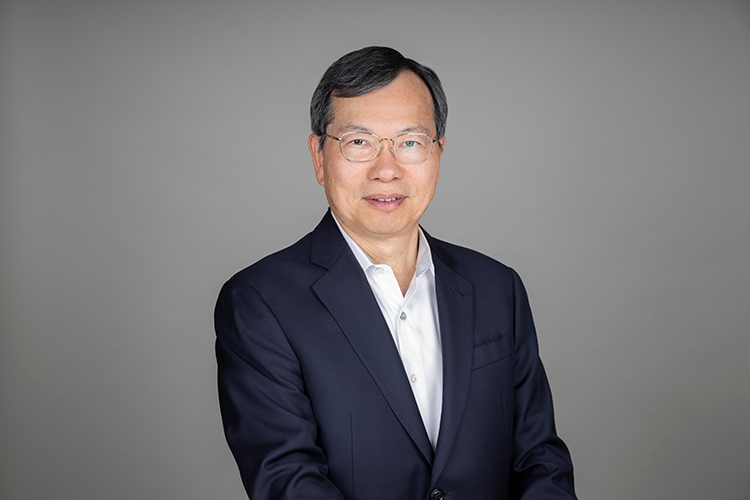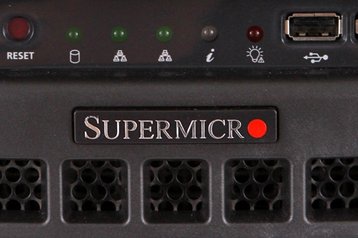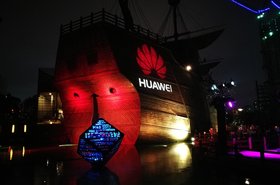Charles Liang has been building servers for a long time.
"Supermico started 28 years ago," he told me repeatedly during our conversation. "28 years ago we were a startup company, three people in a garage."
During this lengthy tenure as CEO, Liang has seen his company grow out of that garage to become a major server manufacturer at the forefront of the digital revolution. We talked about that journey, the company’s next step, and that Bloomberg article.
Liang was born in Taiwan, but Supermicro is very much an American success story. After graduating from the University of Texas (Arlington), Liang spent several years as an engineer at Silicon Valley firms like Chips & Technologies and Suntek. Then, in 1993, he formed his own motherboard company out of San Jose - initially targeting PCs, but soon pivoting to servers.
The company has always tried to leverage its global heritage, relying on domestic design teams and a mixture of US and overseas production to build a server empire.
Its future now is reliant on that international approach, with foreign markets key to growth and lower costs. But its Asian roots have also seen it buffeted by global tensions far too large for it to control, threatening the company’s reputation and profitability.
Supermicro first opened a campus in Taiwan back in 2010, but - seeing growing APAC demand, looking to lower costs, and needing to reduce its reliance on Chinese manufacturers - it began work on a much larger complex in Liang’s homeland in 2018.
"For the past three years, we have been aggressively expanding our campus in Taiwan,” Liang said. “That has helped us a lot during Covid,” although it took a $30m hit last year due to the pandemic. Now, as the virus spreads across the island nation, forcing shutdowns, he hopes that the Silicon Valley and Netherlands campuses will help pick up any of the slack.
“So far, the impact [of Covid in Taiwan] is relatively more controllable,” Liang said, adding that the campus was designed during Covid and therefore is built with the pandemic in mind. “We already keep separation, different buildings for different functions, as a core idea.”
Taiwan is key to the company's next phase, where it can produce servers for far less than in the US, more easily competing for hyperscale customers. It also expects to be able to nearly double production capacity, manufacturing over two million servers per year by this summer.
In its latest quarterly report, the company detailed a noticeable sales "weakness in the United States," but said it was offset by "double-digit" growth in many Asian and European countries.
The investment comes at a critical time for a business competing against established OEMs and a growing number of ODMs.
This article appeared in Issue 41 of the DCD>Magazine. Subscribe for free today
To brand or not to brand?
Original equipment manufacturers such as Dell and HPE sell branded products with hardware solutions, vendor support, and - crucially - trust. As the old adage goes, no one gets fired for buying IBM.
Original design manufacturers, on the other hand, cut out a lot of that support, a lot of the branding, and get rid of large sales teams and marketing budgets. It's often a race to the bottom on pricing, with no-name 'white box' companies competing over large orders for hyperscalers.
Those hyperscalers, with huge in-house engineering teams, don't need to pay extra for help from the likes of Dell, the way smaller businesses or non-tech enterprises do.
Given the rise of the cloud, the ODM model steadily building customer trust, and the slow growth of the ODM-friendly Open Compute Project, demand for ODM servers has rocketed.
In 2020, a year of firsts, ODM server sales outpaced OEMs for the first time.
Throughout this decade-long shift in data center compute consumption, Supermicro has tried to straddle both worlds.
"We support an OEM model Supermicro brand name. At the same time, we have ODM function as well," Liang explained. "A customer who buys a large volume - they care about cost. We give them a brand name for that, but at an ODM price. It's challenging, but it works."
Supermicro also sells millions of subsystems and components, including motherboards, various plug-in cards, and system enclosures, to value-added resellers, systems integrators, and even other OEMs.
The hybrid approach has allowed it to sell a huge number of servers to IBM Cloud (thought to be its biggest single customer), develop custom hardware for Nutanix, and high-performance computing (HPC) servers for small tech companies like Elemental Technologies, as well as bring in billions in component sales.
The company has long shrugged off the growth of rival ODMs, contending that the primarily Chinese businesses have lower R&D expenditure and that their focus on rock-bottom prices shows in the end product.
It has leaned heavily on its ‘designed in Silicon Valley’ credentials to bolster its brand.
That argument may have held true for several years, but a prolonged period of ODM growth and competition within the sector has meant that many of the leading companies like Wiwynn, Foxconn, and Quanta are now reliable and formidable competitors.
At the same time, Supermicro’s shift to Taiwanese bulk production faces competition from local rivals. A new crop of domestic ODMs have entered the market hoping to carve out a space for themselves, including Gigabyte Technology, AIC, Asustek Computer and Mitac Computing Technology. All of those businesses, a 2019 Digitimes report claimed, were vying for Amazon Web Services (China) orders that had traditionally gone to Supermicro.
"I'm very confident with our solution," Liang counters. “I feel I'm really lucky. Since I started the company 28 years ago, we have used the building block solution as our key architecture.”
Single subsystem
Liang explained that the company designed a single subsystem that is “compatible across the product line, even across different generations or products.” This composable infrastructure “helps us lower our cost and simplify our inventory, and improve our lead time, because we are using the building block solution for all our subsystems.”
When a customer asks for a unique order, Supermicro “pulls out our standard subsystem for our building block solution, and we are able to integrate a customer application-optimized solution quickly because we share the same inventory,” Liang claimed. “Not just lower cost, but a shared inventory that helps us have room to support tier two, tier three customers quicker and with a better price.”
The company has hundreds of server variants based on its core solution, and in 2020 went more aggressively after the hyperscale market with its new MegaDC and CloudDC line.
As new chip architectures come onto the scene, Liang said that the building block’s flexibility is proving useful, with Intel’s dominance of server compute being chipped away. “It doesn't matter which CPU or GPU,” he said. “One building block solution for all different kinds of CPU, GPU, and for different kinds of customer.”
Liang says that the success of this building block solution is down to a mixture of luck, foresight, and time. "We spent the 28 years just focused on one single topic: Bringing the best hardware to the customer."
There’s been another focus for the company, one he is keen to share, with Liang breaking into lengthy explanations even when asked unrelated questions. That subject is Green compute.
More than a decade ago, Liang began focusing on server efficiency, with old videos at Computex showing him warning of rapidly rising data center energy use amid a warming climate.
Efforts by his company and others have staved off some of the direst predictions. A 2020 study by Lawrence Berkeley National Laboratory found that global data center compute rose by 550 percent between 2010 and 2018. In that same time, energy use rose just six percent.
But there's still a long way to go, Liang argues, especially with compute demands rising and CPU improvements slowing. "Green computing can save energy costs, and it's a good idea for our planet, reducing our carbon footprint," Liang said, launching into a detailed defense of a slightly higher capex for an ROI that he claims can be measured in months.
Supermicro also uses a 3MW Bloom energy fuel cell to reduce emissions and long-term costs at its San Francisco site, and has other eco-friendly initiatives like its e-waste reducing disaggregated server architecture.
"[We must] reduce carbon footprint, make our planet healthier," Liang said. "These fossil fuel power plants are still everywhere."
Of course, despite the lofty intention of helping the planet, the company suffers from the same ethical lapses as many in the tech sector: It is a major supplier to the oil and gas industry, delivering HPC equipment to help them find and exploit new fossil reserves.
Liang, head of the Green Earth Charitable Organization, dodged questions about any hypocrisy in selling to those still building the fossil fuel power plants he argues we need to eliminate. "They care a lot about energy efficiency too," he said.
"We have some oil and gas companies that go for a liquid submerged solution with us and some others that go for liquid cooling. The energy companies pay attention to energy consumption - although they generate energy, they care."
Indeed, companies across all industries care now more than ever about energy consumption. Liang said that his focus on green compute was finally paying off, as the world grapples with climate change.
This new business opportunity comes after a rocky few years for the storied company.
Hit by the SEC... and Bloomberg
In 2017, it was revealed that the company was improperly and prematurely recognizing revenue for fiscal 2015 through fiscal 2017. In an effort to boost its numbers, it recognized revenue on servers it had yet to deliver to customers, shipped servers to customers prior to customer authorization, and shipped misassembled goods to customers.
A subsequent Securities and Exchange Commission investigation fined the company $17.5 million, and Supermicro replaced much of its executive team - but neither admitted nor denied the SEC’s findings.
“Supermicro is committed to conducting our business ethically and transparently,” Liang said in 2020. “We fell short of our standards, and we have implemented numerous remedial actions and internal control enhancements to prevent such errors from recurring.”
Liang was not himself accused of misconduct, but had to reimburse $2.1m in stock profits in a separate settlement.
Delays in reporting financial results due to the lengthy audit meant that the company was delisted from the Nasdaq in August 2018, a deeply embarrassing event. It took until January 2020 to return.
As it was still reeling from the delisting, it got hit by something much worse: A devastating claim that its products were spying on its biggest customers.
In what read like something ripped from the pages of a Hollywood screenplay, Bloomberg Businessweek said in 2018 that Chinese spies had infiltrated Supermicro's supply chain. The People’s Liberation Army was adding tiny microchips, no bigger than a grain of rice, to Supermicro motherboards to get access to US state secrets, the publication claimed.
Bloomberg said Amazon discovered the chip when doing due diligence on a potential acquisition, Elemental Technologies. It informed the FBI, as did Apple, which soon removed all Supermicro servers from its data centers.
Other impacted businesses include a major bank, government contractors, Department of Defense data centers, and the CIA, the publication reported in an article citing 17 people familiar with the matter, including six current and former senior national security officials.
Bloomberg said that Supermicro’s international setup had left it open to attack. Not only was it relying on China for manufacturing, but its San Jose offices were primarily staffed by Taiwanese and Chinese employees, with Mandarin the preferred language. This made it easier for China to understand the company’s operations, Bloomberg alleges, although investigations are still ongoing as to whether any spies were planted within the company (a subsequent report claimed the FBI surveilled several suspicious employees).
The story took a surreal segue when, not long after the article was published, I met with a number of Department of Energy employees for a drink. When asked what they thought of the rumor, most laughingly brushed it aside as highly unlikely. But one individual, who said he had been traveling and not following the news, jumped up abruptly when I explained the story. He said that he had to make a phone call, and ran out the door. When he returned some time later, he would not allow the subject to be broached, but was clearly disconcerted.
The following few weeks proved just as strange. Cyber security experts picked at various parts of the story, and every company named in the report came forward to vociferously deny it.
"We want to assure you that a recent report in Bloomberg Businessweek alleging the compromise of our servers is not true," Apple said, taking the unusual step of writing a letter to Congress denying the article. "You should know that Bloomberg provided us with no evidence to substantiate their claims and our internal investigations concluded their claims were simply wrong."
AWS CEO Andy Jassy added: "[The] Bloomberg story is wrong about Amazon, too. They offered no proof, [the] story kept changing, and [they] showed no interest in our answers unless we could validate their theories. Reporters got played or took liberties. Bloomberg should retract."
Major security agencies also denied the report, loudly and aggressively - the NSA went as far as to say it was "befuddled" by the article. And yet, Bloomberg stood by its reporting, claiming it had conducted more than 100 interviews to build a picture of the hack.
"Although details have been very tightly held, there is physical evidence out there in the world," one of the article’s authors, Michael Riley, said on Twitter at the time.
"Now that details are out, it will be hard to keep more from emerging," said Riley. And yet, so far, nothing has emerged.
Supermicro pushed back against the claims, although Bloomberg said that it is likely the company had no idea about the hack. Third-party investigations firm Nardello & Co, hired by Supermicro to probe its supply chain, was unable to find any evidence of such a hack.
As Supermicro has not taken Bloomberg to court, the claims have not been legally tested.
In the immediate aftershock of the story, Supermicro's share price halved. An unknown number of customers left or paused purchases. Supermicro was forced to shift manufacturing out of China - although it now claims it was doing that anyway, partially because of the trade war.
Slowly, but surely, it put the allegation in its rearview mirror. No evidence has been produced. Most of its major customers stayed with it, though Apple admitted it has left Supermicro, apparently for other reasons.
Then Bloomberg struck again.
This February, after more than two years, the publication doubled down on its original allegations, providing more context to its claims, but still no concrete proof. It said that the DoD found that its Supermicro servers were sending network data to China via secret chips way back in 2010, and that a similar incident occurred at Intel in 2014.
It should be noted that when I visited an Intel data center in 2019, the company was still very much a fan of Supermicro - nearly all of the facility's 150,000 servers came from them, and Intel proudly displayed its disaggregated server joint venture, dreamed up after a talk with Liang in 2016.
"I met with Liang, and then six weeks later we had 10,000 servers deployed - it's never been done in the industry that fast," Intel IT CTO Shesha Krishnapura told me at the time, crediting the building block strategy. "Now we have more than 80,000 disaggregated servers."
Bloomberg also alleges that the US government took steps to isolate Supermicro servers from classified networks, but in many cases left them unaltered to avoid alerting the Chinese government that they were onto them. Before showing their hand, US officials wanted to discover the hackers' aims.
The cyber security community remains highly suspicious of the article, and Bloomberg has not responded to requests for comment from DCD and others.
"The Bloomberg story is fake news, from our understanding," Liang told DCD. "We have never heard any customer have that experience, and we’ve never seen anything like that. For sure, we continue to improve the security of our production and supply chain, and make our testing system more robust to cover more angles.
"Nothing really happened. However, we keep paranoid and try to make sure our solutions are safe to our customers."
This time, the report had less impact, only briefly denting the Supermicro share price. Now, the company is close to beating its all-time high of $40 a share, achieved back in 2015, before all the accounting issues and hacking drama. Admittedly, this has somewhat been boosted by a generous stock buyback initiative.
While he would not be drawn on specific numbers, Liang said that the Bloomberg story did not lead to a mass customer exodus. "Nothing is more beautiful than the reality, the truth is the truth."
And global political quarrels may yet prove a boon to Supermicro. Rival Inspur, which also tries to be both an OEM and an ODM (and has come up with the term Joint Design Manufacturing), is now in the crosshairs of the US government.
China's first server manufacturer, Inspur quickly became its homeland's largest supplier by highlighting its lack of US ties amid the growing NSA surveillance scandal brought to light by Edward Snowden in 2014.
But now the US claims its alleged links to the Chinese military-industrial complex are a threat to national security. In November 2020, President Donald Trump signed an executive order blocking US entities from investing in the world's third-largest server manufacturer. President Biden reaffirmed the ban in a new EO in June 2021.
As of publication, the US has yet to put Inspur on its 'Entity List', alongside several other Chinese firms that Americans are blocked from investing in. Such an addition would bar US companies working with Inspur, including major chip firms, and could damage Inspur just like Huawei before it.
The Commerce Department declined to comment about its decision-making process. Inspur previously denied it was linked to the Chinese government, but did not respond to requests for comment.
For Liang, such global tensions are part of business, just the latest chapter in the story of a company that has overcome pandemics and shortages, claims of hacks, and accounting irregularities. He has seen it all before, and he will see it all again.
He repeated: "I have been at this company for 28 years."




